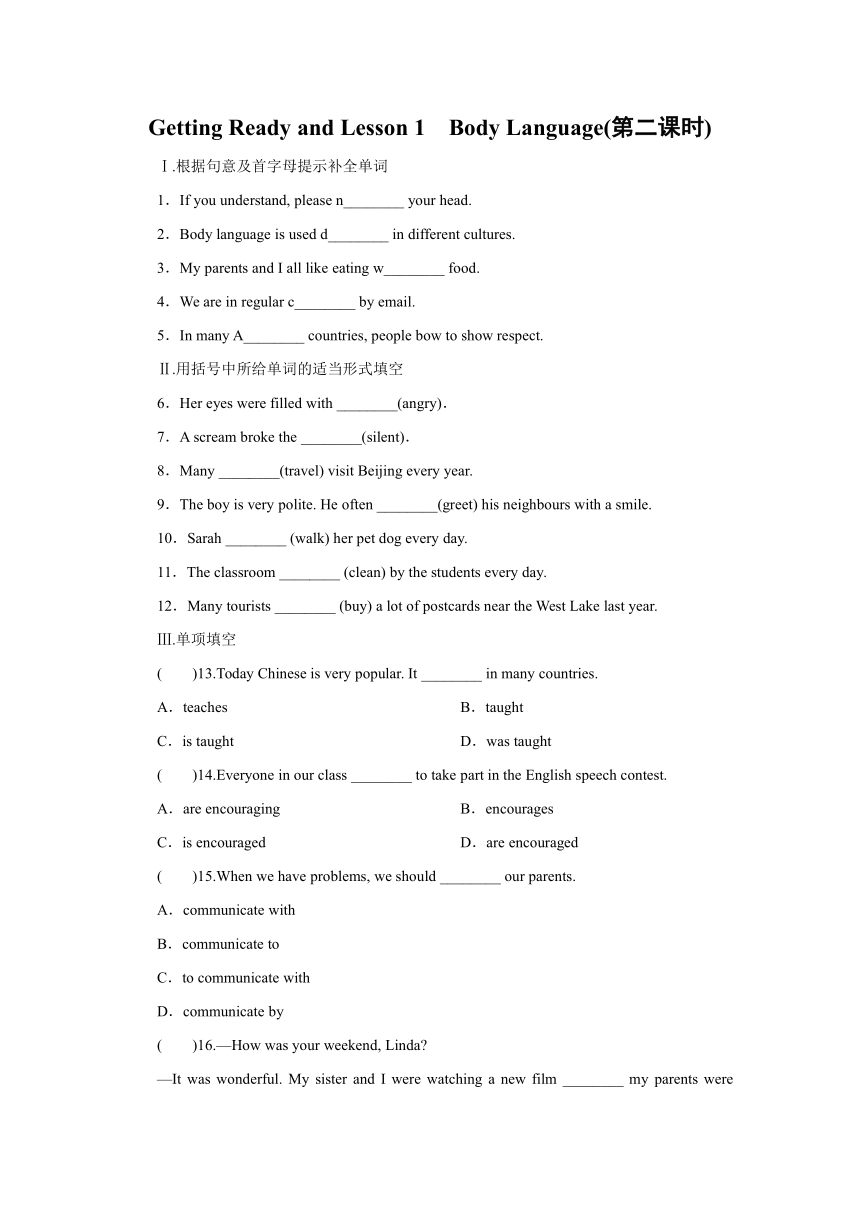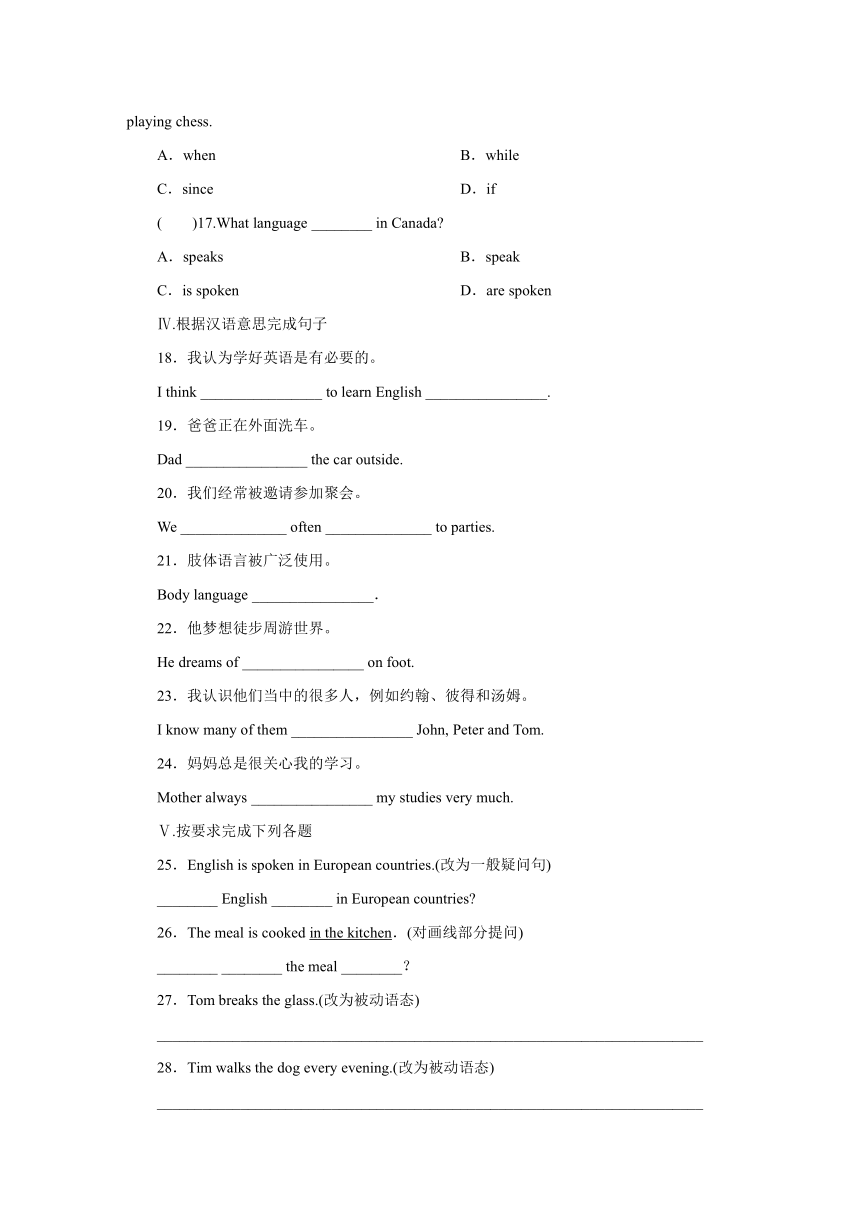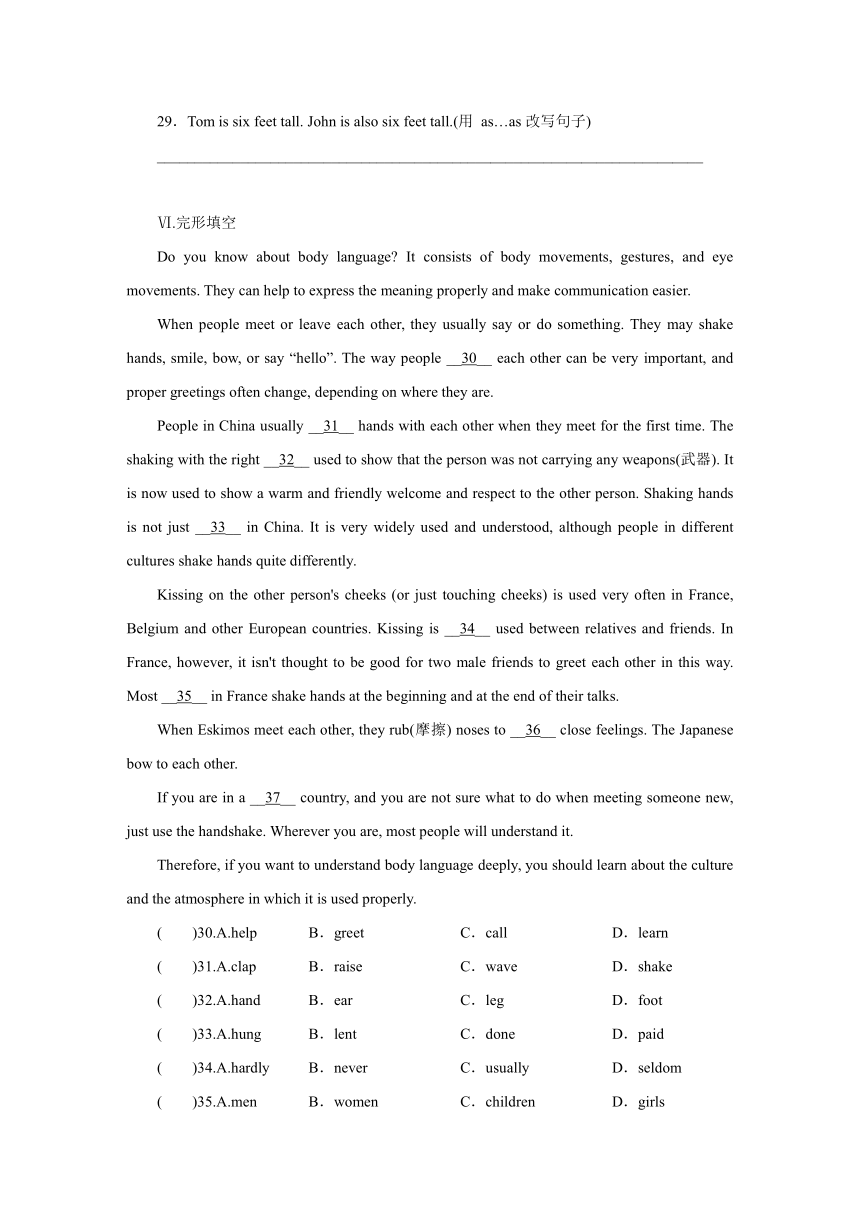Unit 1 Language Getting Ready and Lesson 1 Body Language(第二课时)同步课时练习(word版,含答案)
文档属性
| 名称 | Unit 1 Language Getting Ready and Lesson 1 Body Language(第二课时)同步课时练习(word版,含答案) |  | |
| 格式 | docx | ||
| 文件大小 | 26.8KB | ||
| 资源类型 | 教案 | ||
| 版本资源 | 北师大版 | ||
| 科目 | 英语 | ||
| 更新时间 | 2022-05-02 09:52:01 | ||
图片预览



文档简介
Getting Ready and Lesson 1 Body Language(第二课时)
Ⅰ.根据句意及首字母提示补全单词
1.If you understand, please n________ your head.
2.Body language is used d________ in different cultures.
3.My parents and I all like eating w________ food.
4.We are in regular c________ by email.
5.In many A________ countries, people bow to show respect.
Ⅱ.用括号中所给单词的适当形式填空
6.Her eyes were filled with ________(angry).
7.A scream broke the ________(silent).
8.Many ________(travel) visit Beijing every year.
9.The boy is very polite. He often ________(greet) his neighbours with a smile.
10.Sarah ________ (walk) her pet dog every day.
11.The classroom ________ (clean) by the students every day.
12.Many tourists ________ (buy) a lot of postcards near the West Lake last year.
Ⅲ.单项填空
( )13.Today Chinese is very popular. It ________ in many countries.
A.teaches B.taught
C.is taught D.was taught
( )14.Everyone in our class ________ to take part in the English speech contest.
A.are encouraging B.encourages
C.is encouraged D.are encouraged
( )15.When we have problems, we should ________ our parents.
A.communicate with
B.communicate to
C.to communicate with
D.communicate by
( )16.—How was your weekend, Linda
—It was wonderful. My sister and I were watching a new film ________ my parents were playing chess.
A.when B.while
C.since D.if
( )17.What language ________ in Canada
A.speaks B.speak
C.is spoken D.are spoken
Ⅳ.根据汉语意思完成句子
18.我认为学好英语是有必要的。
I think ________________ to learn English ________________.
19.爸爸正在外面洗车。
Dad ________________ the car outside.
20.我们经常被邀请参加聚会。
We ______________ often ______________ to parties.
21.肢体语言被广泛使用。
Body language ________________.
22.他梦想徒步周游世界。
He dreams of ________________ on foot.
23.我认识他们当中的很多人,例如约翰、彼得和汤姆。
I know many of them ________________ John, Peter and Tom.
24.妈妈总是很关心我的学习。
Mother always ________________ my studies very much.
Ⅴ.按要求完成下列各题
25.English is spoken in European countries.(改为一般疑问句)
________ English ________ in European countries
26.The meal is cooked in the kitchen.(对画线部分提问)
________ ________ the meal ________?
27.Tom breaks the glass.(改为被动语态)
________________________________________________________________________
28.Tim walks the dog every evening.(改为被动语态)
________________________________________________________________________
29.Tom is six feet tall. John is also six feet tall.(用 as…as改写句子)
________________________________________________________________________
Ⅵ.完形填空
Do you know about body language It consists of body movements, gestures, and eye movements. They can help to express the meaning properly and make communication easier.
When people meet or leave each other, they usually say or do something. They may shake hands, smile, bow, or say “hello”. The way people __30__ each other can be very important, and proper greetings often change, depending on where they are.
People in China usually __31__ hands with each other when they meet for the first time. The shaking with the right __32__ used to show that the person was not carrying any weapons(武器). It is now used to show a warm and friendly welcome and respect to the other person. Shaking hands is not just __33__ in China. It is very widely used and understood, although people in different cultures shake hands quite differently.
Kissing on the other person's cheeks (or just touching cheeks) is used very often in France, Belgium and other European countries. Kissing is __34__ used between relatives and friends. In France, however, it isn't thought to be good for two male friends to greet each other in this way. Most __35__ in France shake hands at the beginning and at the end of their talks.
When Eskimos meet each other, they rub(摩擦) noses to __36__ close feelings. The Japanese bow to each other.
If you are in a __37__ country, and you are not sure what to do when meeting someone new, just use the handshake. Wherever you are, most people will understand it.
Therefore, if you want to understand body language deeply, you should learn about the culture and the atmosphere in which it is used properly.
( )30.A.help B.greet C.call D.learn
( )31.A.clap B.raise C.wave D.shake
( )32.A.hand B.ear C.leg D.foot
( )33.A.hung B.lent C.done D.paid
( )34.A.hardly B.never C.usually D.seldom
( )35.A.men B.women C.children D.girls
( )36.A.catch B.hold C.walk D.show
( )37.A.beautiful B.foreign C.poor D.rich
Ⅶ.阅读短文,根据短文内容回答问题
Body language is one of the most powerful means of communication, often even more powerful than the spoken language. People around the world show all kinds of feelings, wishes and attitudes(态度) that they might never speak aloud. It is possible to read others around us, even if they do not want us to catch their unspoken communication. Of course, body language can be misread, but many gestures and actions are common.
The most common facial expression is, of course, the smile—its function(作用) is to show happiness and to put people at ease. However, it does not always mean that we are truly happy. Smiles around the world can be false, hiding other feelings like anger, fear or worry. There are unhappy smiles, for example, when someone loses face, he or she may smile to hide it. Of course, the general purpose of smiling is to show good feelings.
From the time we are babies, we show unhappiness or anger by frowning(皱眉头). In most places around the world, frowning and turning one's back to someone shows anger. Making a fist(拳头) and shaking it almost always means that someone is angry.
How to show that we are bored Looking away from people or yawning(打哈欠) will, in most cases, make us appear to be uninterested. However, if we turn toward and look at someone or something, people from almost every culture will think that we are interested.
Being respectful(恭敬的) to people is subjective, based on each culture, but in general it is probably not a good idea to give a hug to a boss or a teacher. In almost every culture, it is not usually good to stand too close to someone of a higher rank(等级). Standing at a little distance with open hands will show that we are willing to listen.
With so many cultural differences between people, it is great to have some similarities in body language.
38.What is even more powerful than the spoken language according to the passage
________________________________________________________________________
39.What is the most common facial expression
________________________________________________________________________
40.How do babies normally show their anger
________________________________________________________________________
41.What is not good when we stay with someone of a higher rank
________________________________________________________________________
42.What does the writer mainly want to tell us
________________________________________________________________________
答案
Ⅰ.1.nod 2.differently 3.western
4.communication 5.Asian
Ⅱ.6.anger 7.silence 8.travellers
9.greets 10.walks 11.is cleaned
12.bought
Ⅲ.13.C 一般现在时的被动语态。句意为“现今,汉语非常受欢迎。许多国家教中文”。主语和谓语之间为被动关系,排除A、B;由Today可知用一般现在时。
14.C 15.A 16.B 17.C
Ⅳ.18.it is necessary, well 19.is washing
20.are, invited 21.is widely used
22.travelling around the world 23.such as
24.cares about
Ⅴ.25.Is, spoken
26.Where is, cooked
27.The glass is broken by Tom.
28.The dog is walked by Tim every evening.
29.Tom/John is as tall as John/Tom.
Ⅵ.30—34 BDACC 35—37 ADB
Ⅶ.38.Body language. 根据文中信息“Body language is one of the most powerful means of communication, often even more powerful than the spoken language.”可知。
39.The smile. 根据文中信息“The most common facial expression is, of course, the smile”可知。
40.By frowning. 根据文中信息“From the time we are babies, we show unhappiness or anger by frowning.”可知。
41.To give a hug or to stand too close to him or her. 根据文中信息“…but in general it is probably not a good idea to give a hug to a boss or a teacher. In almost every culture, it is not usually good to stand too close to someone of a higher rank.”可知。
42.Some similarities in body language./Some common gestures and actions.
Ⅰ.根据句意及首字母提示补全单词
1.If you understand, please n________ your head.
2.Body language is used d________ in different cultures.
3.My parents and I all like eating w________ food.
4.We are in regular c________ by email.
5.In many A________ countries, people bow to show respect.
Ⅱ.用括号中所给单词的适当形式填空
6.Her eyes were filled with ________(angry).
7.A scream broke the ________(silent).
8.Many ________(travel) visit Beijing every year.
9.The boy is very polite. He often ________(greet) his neighbours with a smile.
10.Sarah ________ (walk) her pet dog every day.
11.The classroom ________ (clean) by the students every day.
12.Many tourists ________ (buy) a lot of postcards near the West Lake last year.
Ⅲ.单项填空
( )13.Today Chinese is very popular. It ________ in many countries.
A.teaches B.taught
C.is taught D.was taught
( )14.Everyone in our class ________ to take part in the English speech contest.
A.are encouraging B.encourages
C.is encouraged D.are encouraged
( )15.When we have problems, we should ________ our parents.
A.communicate with
B.communicate to
C.to communicate with
D.communicate by
( )16.—How was your weekend, Linda
—It was wonderful. My sister and I were watching a new film ________ my parents were playing chess.
A.when B.while
C.since D.if
( )17.What language ________ in Canada
A.speaks B.speak
C.is spoken D.are spoken
Ⅳ.根据汉语意思完成句子
18.我认为学好英语是有必要的。
I think ________________ to learn English ________________.
19.爸爸正在外面洗车。
Dad ________________ the car outside.
20.我们经常被邀请参加聚会。
We ______________ often ______________ to parties.
21.肢体语言被广泛使用。
Body language ________________.
22.他梦想徒步周游世界。
He dreams of ________________ on foot.
23.我认识他们当中的很多人,例如约翰、彼得和汤姆。
I know many of them ________________ John, Peter and Tom.
24.妈妈总是很关心我的学习。
Mother always ________________ my studies very much.
Ⅴ.按要求完成下列各题
25.English is spoken in European countries.(改为一般疑问句)
________ English ________ in European countries
26.The meal is cooked in the kitchen.(对画线部分提问)
________ ________ the meal ________?
27.Tom breaks the glass.(改为被动语态)
________________________________________________________________________
28.Tim walks the dog every evening.(改为被动语态)
________________________________________________________________________
29.Tom is six feet tall. John is also six feet tall.(用 as…as改写句子)
________________________________________________________________________
Ⅵ.完形填空
Do you know about body language It consists of body movements, gestures, and eye movements. They can help to express the meaning properly and make communication easier.
When people meet or leave each other, they usually say or do something. They may shake hands, smile, bow, or say “hello”. The way people __30__ each other can be very important, and proper greetings often change, depending on where they are.
People in China usually __31__ hands with each other when they meet for the first time. The shaking with the right __32__ used to show that the person was not carrying any weapons(武器). It is now used to show a warm and friendly welcome and respect to the other person. Shaking hands is not just __33__ in China. It is very widely used and understood, although people in different cultures shake hands quite differently.
Kissing on the other person's cheeks (or just touching cheeks) is used very often in France, Belgium and other European countries. Kissing is __34__ used between relatives and friends. In France, however, it isn't thought to be good for two male friends to greet each other in this way. Most __35__ in France shake hands at the beginning and at the end of their talks.
When Eskimos meet each other, they rub(摩擦) noses to __36__ close feelings. The Japanese bow to each other.
If you are in a __37__ country, and you are not sure what to do when meeting someone new, just use the handshake. Wherever you are, most people will understand it.
Therefore, if you want to understand body language deeply, you should learn about the culture and the atmosphere in which it is used properly.
( )30.A.help B.greet C.call D.learn
( )31.A.clap B.raise C.wave D.shake
( )32.A.hand B.ear C.leg D.foot
( )33.A.hung B.lent C.done D.paid
( )34.A.hardly B.never C.usually D.seldom
( )35.A.men B.women C.children D.girls
( )36.A.catch B.hold C.walk D.show
( )37.A.beautiful B.foreign C.poor D.rich
Ⅶ.阅读短文,根据短文内容回答问题
Body language is one of the most powerful means of communication, often even more powerful than the spoken language. People around the world show all kinds of feelings, wishes and attitudes(态度) that they might never speak aloud. It is possible to read others around us, even if they do not want us to catch their unspoken communication. Of course, body language can be misread, but many gestures and actions are common.
The most common facial expression is, of course, the smile—its function(作用) is to show happiness and to put people at ease. However, it does not always mean that we are truly happy. Smiles around the world can be false, hiding other feelings like anger, fear or worry. There are unhappy smiles, for example, when someone loses face, he or she may smile to hide it. Of course, the general purpose of smiling is to show good feelings.
From the time we are babies, we show unhappiness or anger by frowning(皱眉头). In most places around the world, frowning and turning one's back to someone shows anger. Making a fist(拳头) and shaking it almost always means that someone is angry.
How to show that we are bored Looking away from people or yawning(打哈欠) will, in most cases, make us appear to be uninterested. However, if we turn toward and look at someone or something, people from almost every culture will think that we are interested.
Being respectful(恭敬的) to people is subjective, based on each culture, but in general it is probably not a good idea to give a hug to a boss or a teacher. In almost every culture, it is not usually good to stand too close to someone of a higher rank(等级). Standing at a little distance with open hands will show that we are willing to listen.
With so many cultural differences between people, it is great to have some similarities in body language.
38.What is even more powerful than the spoken language according to the passage
________________________________________________________________________
39.What is the most common facial expression
________________________________________________________________________
40.How do babies normally show their anger
________________________________________________________________________
41.What is not good when we stay with someone of a higher rank
________________________________________________________________________
42.What does the writer mainly want to tell us
________________________________________________________________________
答案
Ⅰ.1.nod 2.differently 3.western
4.communication 5.Asian
Ⅱ.6.anger 7.silence 8.travellers
9.greets 10.walks 11.is cleaned
12.bought
Ⅲ.13.C 一般现在时的被动语态。句意为“现今,汉语非常受欢迎。许多国家教中文”。主语和谓语之间为被动关系,排除A、B;由Today可知用一般现在时。
14.C 15.A 16.B 17.C
Ⅳ.18.it is necessary, well 19.is washing
20.are, invited 21.is widely used
22.travelling around the world 23.such as
24.cares about
Ⅴ.25.Is, spoken
26.Where is, cooked
27.The glass is broken by Tom.
28.The dog is walked by Tim every evening.
29.Tom/John is as tall as John/Tom.
Ⅵ.30—34 BDACC 35—37 ADB
Ⅶ.38.Body language. 根据文中信息“Body language is one of the most powerful means of communication, often even more powerful than the spoken language.”可知。
39.The smile. 根据文中信息“The most common facial expression is, of course, the smile”可知。
40.By frowning. 根据文中信息“From the time we are babies, we show unhappiness or anger by frowning.”可知。
41.To give a hug or to stand too close to him or her. 根据文中信息“…but in general it is probably not a good idea to give a hug to a boss or a teacher. In almost every culture, it is not usually good to stand too close to someone of a higher rank.”可知。
42.Some similarities in body language./Some common gestures and actions.
同课章节目录
- Unit 1 Language
- Lesson 1 Body Language
- Lesson 2 Different Kinds of Language
- Lesson 3 Language Learning Tips
- Communication Workshop
- Unit 2 Books
- Lesson 4 Classics
- Lesson 5 The Book Club
- Lesson 6 Tom Sawye
- Communication Workshop
- Unit 3 Creativity
- Lesson 7 A Famous Invento
- Lesson 8 Good or Bad?
- Lesson 9 Creative Minds
- Communication Workshop
- Unit 4 Space
- Lesson 10 Life in Space
- Lesson 11 The Amazing Shenzhou
- Lesson 12 The Spaceship
- Communication Workshop
- Unit 5 Literature
- Lesson 13 Anne of Green Gables
- Lesson 14 The Dark Room
- Lesson 15 A Famous Write
- Communication Workshop
- Unit 6 Role Models
- Lesson 16 Yao Ming
- Lesson 17 People in Our Lives
- Lesson 18 Steve Jobs
- Communication Workshop
- Unit 7 Journeys
- Lesson 19 The Silk Road
- Lesson 20 Life in a Journey
- Lesson 21 To the South Pole
- Communication Workshop
- Unit 8 Discoveries
- Lesson 22 Famous Discoveries
- Lesson 23 Discovery of the Yea
- Lesson 24 An Experiment Report
- Communication Workshop
- Unit 9 Save the Planet
- Lesson 25 Going Green
- Lesson 26 Our Rive
- Lesson 27 Tree Heroes
- Communication Workshop
